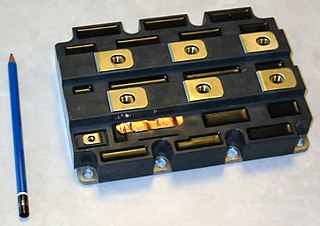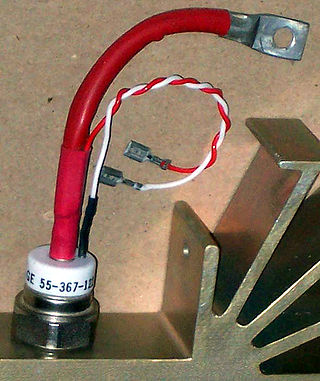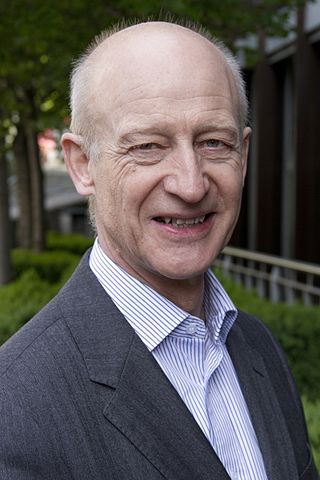
A high-voltage direct current (HVDC) electric power transmission system uses direct current (DC) for electric power transmission, in contrast with the more common alternating current (AC) transmission systems.

A rectifier is an electrical device that converts alternating current (AC), which periodically reverses direction, to direct current (DC), which flows in only one direction. The reverse operation is performed by an inverter.

An insulated-gate bipolar transistor (IGBT) is a three-terminal power semiconductor device primarily forming an electronic switch. It was developed to combine high efficiency with fast switching. It consists of four alternating layers (P–N–P–N) that are controlled by a metal–oxide–semiconductor (MOS) gate structure.

A thyristor is a solid-state semiconductor device which can be thought of as being a highly robust and switchable diode, allowing the passage of current in one direction but not the other, often under control of a gate electrode, that is used in high power applications like inverters and radar generators. It usually consists of four layers of alternating P- and N-type materials. It acts as a bistable switch. There are two designs, differing in what triggers the conducting state. In a three-lead thyristor, a small current on its gate lead controls the larger current of the anode-to-cathode path. In a two-lead thyristor, conduction begins when the potential difference between the anode and cathode themselves is sufficiently large. The thyristor continues conducting until the voltage across the device is reverse-biased or the voltage is removed, or through the control gate signal on newer types.

A Flexible Alternating Current Transmission System (FACTS) is a family of Power-Electronic based devices designed for use on an Alternating Current (AC) Transmission System to improve and control Power Flow and support Voltage. FACTs devices are alternatives to traditional electric grid solutions and improvements, where building additional Transmission Lines or Substation is not economically or logistically viable.
A power semiconductor device is a semiconductor device used as a switch or rectifier in power electronics. Such a device is also called a power device or, when used in an integrated circuit, a power IC.

Power electronics is the application of electronics to the control and conversion of electric power.
The following outline is provided as an overview of and topical guide to electrical engineering.
This is an alphabetical list of articles pertaining specifically to electrical and electronics engineering. For a thematic list, please see List of electrical engineering topics. For a broad overview of engineering, see List of engineering topics. For biographies, see List of engineers.

A gate turn-off thyristor (GTO) is a special type of thyristor, which is a high-power semiconductor device. It was invented by General Electric. GTOs, as opposed to normal thyristors, are fully controllable switches which can be turned on and off by their gate lead.

The Swiss Electromagnetics Research and Engineering Centre (SEREC) is the sole organization for handling electromagnetic research and concerns in Switzerland.
A solid-state AC-to-AC converter converts an AC waveform to another AC waveform, where the output voltage and frequency can be set arbitrarily.
Adrian Mihai Ionescu is a Romanian and Swiss physicist and academic. He is full Professor at the Swiss Federal Institute of Technology in Lausanne (EPFL), where he is founder and director of the Nanoelectronic Devices Laboratory.
The following outline is provided as an overview of and topical guide to electronics:
An HVDC converter converts electric power from high voltage alternating current (AC) to high-voltage direct current (HVDC), or vice versa. HVDC is used as an alternative to AC for transmitting electrical energy over long distances or between AC power systems of different frequencies. HVDC converters capable of converting up to two gigawatts (GW) and with voltage ratings of up to 900 kilovolts (kV) have been built, and even higher ratings are technically feasible. A complete converter station may contain several such converters in series and/or parallel to achieve total system DC voltage ratings of up to 1,100 kV.

Claes Göran Andersson is a Swedish academic. He was a full Professor of Power Systems in the Department of Information Technology, Swiss Federal Institute of Technology in Zurich, Switzerland, in 2010–2016 and is now emeritus. He is a Fellow of the Royal Swedish Academy of Engineering Sciences, Royal Swedish Academy of Sciences, and the Swiss Academy of Engineering Sciences. He was also elected as an International Member of the US National Academy of Engineering in 2016 for contributions to the development of high-voltage direct current (HVDC) technology and methods of power system voltage stability analysis.
Sudip K. Mazumder is a UIC Distinguished Professor and is the Director of Laboratory for Energy and Switching-Electronic Systems (LESES) in the Department of Electrical and Computer Engineering at the University of Illinois Chicago (UIC), which he joined in 2001. He has over 30 years of professional experience and has held R&D and design positions in leading industrial organizations, and has served as technical consultant for several industries. He also serves as the President of NextWatt LLC since 2008.

Ursula Keller is a Swiss physicist. She has been a physics professor at the ETH Zurich, Switzerland since 2003 with a speciality in ultra-fast laser technology, an inventor and the winner of the 2018 European Inventor Award by the European Patent Office.
Chen Xingbi was a Chinese electronics engineer and professor at the University of Electronic Science and Technology of China. Known for his invention of superjunction power semiconductor devices, he was elected an academician of the Chinese Academy of Sciences and a life fellow of the Institute of Electrical and Electronics Engineers (IEEE). He was inducted into IEEE's ISPSD Hall of Fame in 2019.

Peter J. Wild is a Swiss electronics engineer and a pioneer of liquid-crystal display (LCD) technology.











